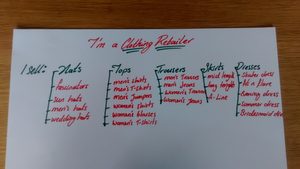You’ve decided to advertise on a Search Engine, like Google, Bing or Yahoo and why wouldn’t you? The digital adspend in the UK was £7,194bn in 2014 and Search advertising made up a massive 52% of that market – check out the IAB’s Full Year Digital Adspend Results for more information on the market!
The first step to building your campaign is keyword planning and it’s not always easy to know where to start. What’s important to remember is that proper keyword planning saves you time in the long run. I really recommend rocking this old skool; go and grab a piece of paper and a pen and at the top of the page write down what your business does in just one word.

Below that write down the different sections of your business; if you are a clothing retailer this might be; hats, tops, trousers, skirts and dresses and if you’re a beauty salon this might be; hair, nails, waxing, facials and massage. You’ll know your business so these should come fairly easily to you. These are your campaigns.
Next, under each of those headings, write down the sub headings for each aspect of your business. In the above examples ‘hats’ may have the sub headings of; fascinators, sun hats, men’s hats and wedding hats and the heading of ‘nails’ might break into; acrylic nails, manicures, pedicures and nail art. These are your ad-groups.
Now, take a look at your piece of paper and take a look at your website. Do they match? There’s a reason we’re doing this – a big part of Google’s auction is the infamous Quality Score. Elements of Quality Score are secret, even to Google employees but the majority of it is transparent and the top of the list is relevance. Your ad should be relevant to your keywords, your keywords should be relevant to your landing page – it’s not rocket science.
What I could have said at the beginning of this blog is, ‘go to your website and write down your pages, these are your campaigns’ however, the chances are (and I do mean this in the nicest possible way) your website might not be up to scratch and then you’ll find yourself with a poor website and a poor AdWords campaign. If the sub headings on your piece of paper are pretty close to your website – just tweak the AdWords campaign but if they’re worlds apart, you need to address your website. It will benefit you in the long run.
The task at hand should now be a lot simpler. Once you’ve broken down your business into small ad-groups, finding the keywords is a breeze. Under your headings (feel free to get digital now and pop that piece of paper into a spreadsheet – the hard part is over) write down three relevant words. Write down words that you would type in to Google (or Bing or Yahoo) to find a product or service like yours. In the example above of sun hats, I might type in big sun hat, buy sun hat or black sun hat and in the example of nails I might type in quick manicure, local manicure or cheap manicure.
If you find yourself wanting to branch out a bit further, using summer hat in place of sun hat then create a new adgroup. If you find yourself writing down things you people will type in but that you don’t do, then don’t add them – if you don’t do cheap manicures (you focus on luxury instead), then don’t have that keyword because people will type it in, they will go to your site, they will see how pricey you are and they will go somewhere else. You just paid for a click that did not convert; focus on getting relevant clicks.
You’ve got yourself a load of ad-groups, each with just three keywords, organised into campaigns. Now try building on that list of keywords by going to the Google Keyword Planner and typing in your ad-group name and your three keywords. It’s pretty much a wizard so follow the instructions and it will give you a list of keywords that it thinks are relevant. Don’t get caught up in all the keywords; only pick out a small group of highly relevant keywords for your campaign.
Going about building your keyword list like this is time consuming and it’s hard work, I know that. This method is about front loading the effort, get it right early on and you’ll put in less work later. At this stage, if you get one thing right, make sure it’s your structure – your keywords will be easy to add and remove but your structure is tied to so much and untangling it later is time consuming. You are not going to get this perfect, you will be changing things every month but getting it close will help you in the long term.
Good luck!
[bctt tweet=”Save Time By Getting Your Keywords Right The First Time!”]
